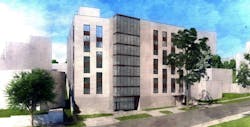Let's get small?
UCLA wants to build a residence hall with rooms that cost students $600 a month. But the University of California Regents have raised concerns that those rooms may be too small and whether that would negatively affect student mental health.
The Los Angeles Times reports that in light of those questions, the regents deferred a vote on the budget and design of the eight-story, 545-bed project.
The planned space is 265 square feet for three beds, desks, closets, storage space and a refrigerator.
Regent John A. Pérez cited research that said “micro-units” have been linked to negative mental health effects.
The regents asked UCLA to come back with more information about the project’s room size and cost per bed compared with others across in University of California system.
UCLA's plans for the new housing call for demolishing an existing structure that houses100 students and constructing the new facility.
At least 350 of the 545 beds would be reserved for low-income students for a $600 monthly housing fee.
Who pays for building schools?
The state of Washington's Supreme Court has ruled that funding for school construction is not the sole responsibility of the state.
The Seattle Times reports that the court found that the state of Washington and local school districts must continue to share the costs of basic school construction.
The decision came in a legal challenge brought by the Wahkiakum School District. The school system, which has less than 500 students, argued that school construction costs should be considered basic education expenses, which the state is primarily responsible for covering.
Wahkiakum was asking for the court to require the state to pay for building the district's elementary, middle and high schools. The cost of doing so was estimated to be more than $50 million.
In a unanimous opinion, the court ruled that school construction expenses were not the responsibility of the state alone.
The state constitution "treats school capital construction costs differently than it treats other education costs and requires the state and local school districts to share the responsibility for those school capital construction costs," the court's opinion stated. "....School capital construction costs are not a component of the 'education' that the state, alone, must amply fund."
Facial recognition
A report from New York state urges schools to exercise caution in their use of biometric identifying technology such as facial recognition.
The Poughkeepsie Journal says that the report from the New York Office of Information Technology Services and the state Education Department identifies "discernable risks," including biometric data breaches, mistaken identification through facial recognition flaws, and students being turned away from school because of technological errors.
"Compromised biometric facial data could result in the disclosure of physical characteristics that cannot be replaced, as compared to a credit card or social security number, which could be changed if necessary," the report said.
The New York legislature called for the report in 2020 as part of a bill that placed a moratorium on schools purchasing and using biometric identifying technology. Lawmakers acted after the Lockport (New York) City School District adopted the technology as part of its security plans. That led to a lawsuit from civil rights advocates over privacy concerns.
About the Author
Mike Kennedy
Senior Editor
Mike Kennedy has been writing about education for American School & University since 1999. He also has reported on schools and other topics for The Chicago Tribune, The Kansas City Star, The Kansas City Times and City News Bureau of Chicago. He is a graduate of Michigan State University.
